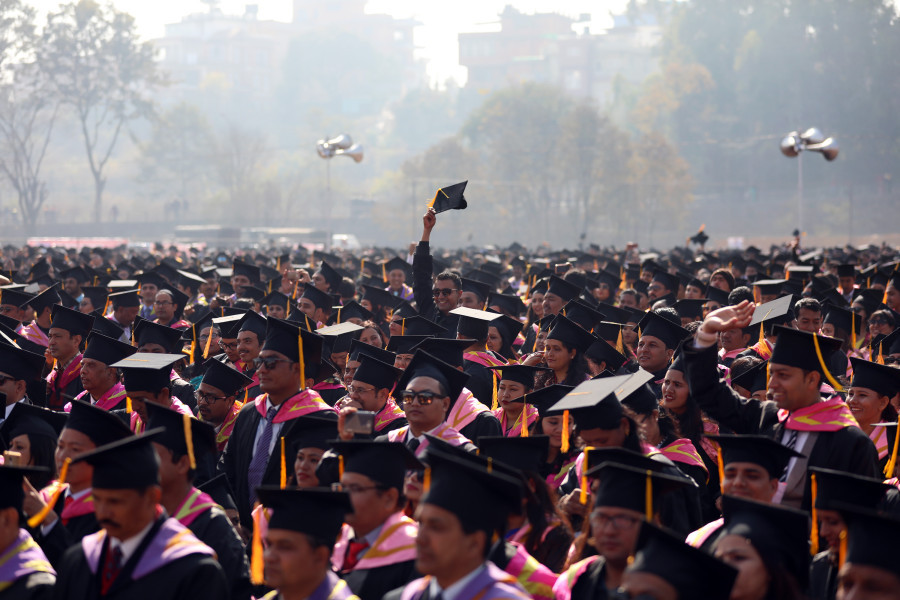Columns
Education diplomacy for Nepal
Even as universities are experiencing low enrollment, we lack plans to attract international students.
Roshee Lamichhane
Education diplomacy is a powerful tool for establishing mutually beneficial relationships between nations. It involves strategically using diplomatic skills and practices to build and maintain relationships and collaborations, fostering partnerships among various stakeholders to achieve common goals in the education sector. Countries view educational opportunities for international students as a critical strategy for advancing their soft power agendas. However, Nepal has yet to realise its value, as the outcry of international students facing visa-related and other issues in Nepal has still not received sufficient attention among policymakers and educators.
A nation's internationalisation policy in higher education is crucial in promoting economic growth and projecting goodwill toward other nations. For example, China has successfully utilised public diplomacy, culture and international education as soft power instruments. The country attracted 255,720 students in 2021 alone by presenting a peaceful and friendly image of its growing economy. China's success is partly attributed to its seven universities, which are ranked in the latest Times Higher Education’s global top 100 world rankings.
In contrast, India's foreign student population, which was approximately 46,000 in 2021-22, remains much lower than that of leading countries like the United States (US), the United Kingdom and Australia, indicating that the government hasn’t fully capitalised on this diplomatic tool. However, India has made a notable progress, as there has been an increase of nearly 42 percent in foreign student enrollment over the past seven years. As part of its rebranding as a net aid provider, India has emphasised education diplomacy by reducing incoming aid, increasing foreign assistance and promoting internationalisation in higher education through initiatives like scholarships, the South Asia University proposal and global outreach expansion through institutions like Indira Gandhi National Open University.
Cultural diversity is a vital aspect of education diplomacy. Many countries, like the US, China and India, engage in extensive cultural exchange programmes rather than just awarding degrees. The International Visitors Leadership Programme (IVLP), a premier professional exchange initiative of the US Department of State, is one of the oldest programmes. Every year, nearly 5,000 International Visitors participate in the IVLP. Through short-term visits to the US, current and emerging foreign leaders in various fields gain firsthand experience and build strong relationships with their American counterparts. Similarly, China fosters cultural exchanges through the Belt and Road Initiative (BRI), while India has institutions like the Indian Council for Cultural Relations (ICCR) to promote cultural interactions.
Education diplomacy is becoming a significant revenue source for governments. Attracting international students by signing a memorandum of understanding with various universities contributes to the universities' reach, reputation and revenue. When a nation positions itself as a higher education centre, its global influence increases. As more international students enrol in higher education institutions (HEIs), the institution's reputation will amplify, aiding in branding and internationalisation. The influx of foreign students also provides a substantial revenue stream for the host country. India is working to internationalise its education system by promoting students, faculties, programmes and campus mobility; all these initiatives support education diplomacy. For instance, an Indian student studying in Nepal will be exposed to the Nepali lifestyle and culture, fostering cultural understanding and bonding between the two countries. Attracting international students can also create a broad base of supporters.
Status of Nepali universities
Nepali universities’ efforts in international relations and collaborations are far from encouraging. With the mass exodus of students abroad, the situation is bleak. There is no evaluation or national ranking system for Nepali HEIs, making it difficult to achieve even moderate rankings globally. The main issue with Nepali HEIs is employability rather than the quality of education. While universities are experiencing low enrollment, no concerted efforts have been made to compensate for this loss by attracting international students to Nepal. Additional challenges include low investment in research and innovation and a lack of competent faculty, leading to fewer university collaborations worldwide. Procedural challenges such as unclear visa policies and difficulties opening bank accounts and payments aggravate the situation. There is also ambiguity regarding the status of dependents or family members accompanying students while coming to Nepal.
Despite the inherent challenges, Kathmandu University (KU) has taken steps to promote internationalisation. For example, foreign faculty members are offered a salary 1.5 times higher than local faculties, a modest effort to attract international talent. The Vice-Chancellor Scholarship Scheme has been introduced, providing scholarships to at least one foreign student in each school based on merit. Moreover, KU is running several programmes in collaboration with international HEIs, such as the M-Tech in Energy Systems (KU-Indian Institute Of Technology (IIT) Madras, India), Bachelor in Yogic Science and Well-being (KU-Sri Visweswara Yoga Research Institute, Tirupati, India), Bachelor of Information Technology (KU-Crown Institute of Higher Education, Australia) and a Joint PhD Program (KU-IIT Hyderabad), among others.
Role of stakeholders
To unleash Nepal’s education sector's potential, continuous support from a robust policy ecosystem, institutional strengthening, and increased investment are required. Although education diplomacy has been limited so far, Nepali diplomats must proactively find solutions. In other countries, presidents or heads of state often visit HEIs to assess the situation and initiate educational activities; however, such practices are uncommon among Nepali diplomats.
The government should immediately work to ensure a smooth and hassle-free entry process for students wishing to study in Nepal. Necessary steps should be taken to make it easier for foreign students to pay tuition and other fees. The process for converting tourist or visit visas to student visas should be expedited. Universities should also provide insurance for foreign students, ensuring their sense of security in a new country. Moreover, universities should mobilise the Nepali diaspora and alums community to market local courses in niche areas, increasing global awareness and interest in Nepali Universities.




 8.79°C Kathmandu
8.79°C Kathmandu.jpg)















